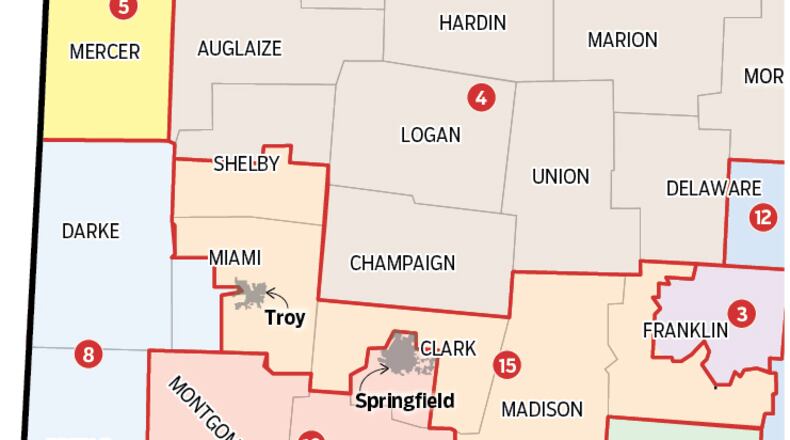In 2020 all of Miami and Clark counties were part of District 8 — currently represented by U.S. Rep. Warren Davidson, R-Troy — while District 10 included the northern half of Fayette County.
Under the map being used this year, only the southwest corner of Miami County and the sliver of Concord Twp. where Davidson lives are still in District 8, which now stretches down into Hamilton County. Davidson faces Democrat Vanessa Enoch for that seat. Enoch lost the 2018 and 2020 elections to Davidson by wide margins.
District 10 covers all of Montgomery and Greene counties, and now also extends north into central Clark County, incorporating Springfield. In that district, Republican incumbent Mike Turner, a Dayton resident, is opposed by fellow Daytonian David Esrati, a Democrat.
The rest of Clark County and much of Miami County, including Troy, is now in District 15. That district runs from Shelby and Miami counties in the west to Franklin County in the east — taking in about half of Columbus. Republican incumbent Mike Carey and Democrat Gary Josephson, both of Columbus, are on the ballot in District 15.
‘Doesn’t really make sense’
Some people interviewed on Main Street in New Carlisle were surprised to learn they are now in District 15.
“I thought we were covered by somebody else,” said Linda Campbell. She gets messages from Davidson “all the time,” she said.
“I don’t know who Mike Carey is. I never heard of him,” Campbell said.
Campbell said she doesn’t think it’s right for New Carlisle to be represented by someone so far away. The new shape of District 15 is a “weird setup,” she said.
“We don’t have much in common with Columbus,” Campbell said.
Robert Carter said he didn’t know anything about Carey. Davidson, who lives just south of Troy, is more in touch with the area, Carter said.
Credit: Bill Lackey
Credit: Bill Lackey
“Doesn’t really make sense to me that somebody that far away represents us, when he doesn’t even know what’s going on around here,” he said.
Amy Hamilton said it doesn’t matter to her that her congressional representative will live 60 miles to the east. She hopes the winner will come to her area and become familiar with its issues.
Miami County
There’s some confusion in Miami County too, where part of the area where Dave Fisher oversees polling locations used to be in Davidson’s district, but is now in District 15. Fisher is chair of the county board of elections.
“I’ve had some conversations with voters about it, especially during the primary when they asked ‘Where’s Warren Davidson on our ballot?’” Fisher said. “I’ve had some reach back out to me and say, ‘Well, that district stretches all the way to Columbus.’ I say, ‘Yes it does.’”
He’s gotten some calls and emails about it too. Most have come from Republicans, since neither district has a Democratic incumbent seeking reelection, Fisher said.
Much of the confusion is due to the months-long delay in establishing new state legislative and congressional district lines, he said. Maps the Ohio Supreme Court have already overturned as unfairly favoring Republicans are nevertheless being used for the 2022 election, and the matter is still in litigation.
The confusion is not unprecedented — there was some a decade ago, the last time district maps changed, Fisher said.
“Unfortunately this year it was a little more so,” he said. Some counties also had special elections, and further confusion over what candidates would be on the ballot.
How we got here
In accordance with 2020 census results, Ohio must reduce its U.S. House seats from 16 to 15. Currently Ohio is represented by 12 Republicans and four Democrats. Despite a 2018 state constitutional amendment aimed at reducing gerrymandering, every map created by the Republican-dominated Ohio Redistricting Commission and General Assembly was unconstitutionally gerrymandered, according to the state supreme court.
But due to primary election deadlines, the most recently rejected map is still being used for the 2022 election cycle.
The current map establishes 10 Republican-leaning and five Democratic-leaning seats. But three of the Democratic-leaning seats only do so by less than 5%, while none of the Republican-leaning districts do so by less than 6.64%, according to the breakdown mapmakers distributed. District 10 is the closest Republican-leaning district, according to figures provided by the map’s Republican sponsors.
Staci Rhine, a professor who teaches American politics and political behavior at Wittenberg University in Springfield, said she hasn’t paid close attention to the congressional race herself. To her, a bigger issue is that map-drawers ignored the will of Ohio voters as expressed in two constitutional amendments intended to reduce partisan gerrymandering.
“I think the unwillingness to follow the state constitution isn’t really being covered enough in Ohio media,” Rhine said.
Voters don’t seem to be making the connection between actions of the Ohio Redistricting Commission and the heavily partisan districts they’re voting in this year, she said. Having so many districts where the outcome is essentially predetermined raises concerns about representation and increasing polarization, Rhine said.
“If you run in a safe district you only have to appeal to a very narrow base,” she said. “Uncompetitive races and pre-drawn districts are bad for everyone. They reduce the desire to compromise and they produce legislation that is not representative of the state, or even of the district for that matter.”
Bill Lackey contributed to this report.
About the Author


